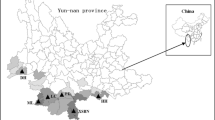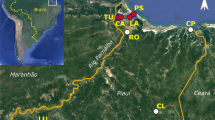Abstract
We used random amplified polymorphic DNA markers (RAPDs) to assess genetic variation between- and within-populations of Anisodus tanguticus (Solanaceae), an endangered perennial endemic to the Qinghai-Tibetan Plateau with important medicinal value. We recorded a total of 92 amplified bands, using 12 RAPD primers, 76 of which (P = 82.61%) were polymorphic, and calculated values of Ht and Hsp of 0.3015 and 0.4459, respectively, suggesting a remarkably high rate of genetic variation at the species level. The average within-population diversity also appeared to be high, with P, He and Hpop values of 55.11%, 0.1948 and 0.2918, respectively. Analyses of molecular variance (AMOVA) showed that among- and between-population genetic variation accounted for 67.02% and 32.98% of the total genetic variation, respectively. In addition, Nei’s coefficient of differentiation (GST) was found to be high (0.35), confirming the relatively high level of genetic differentiation among the populations. These differentiation coefficients are higher than mean corresponding coefficients for outbreeding species, but lower than reported coefficients for some rare species from this region. The genetic structure of A. tanguticus has probably been shaped by its breeding attributes, biogeographic history and human impact due to collection for medicinal purposes. The observed genetic variations suggest that as many populations as possible should be considered in any planned in situ or ex situ conservation programs for this species.




Similar content being viewed by others
References
Bolaric S, Barth S, Melchinger AE, Posselt UK (2005) Genetic diversity in European perennial ryegrass cultivars investigated with RAPD markers. Plant Breed 124:161–166
Borowsky R (2001) Estimating nucleotide diversity from random amplified polymorphic DNA and amplified fragment length polymorphism data. Mol Phylogenet Evol 18:143–148
Bussell JD (1999) The distribution of random amplified polymorphic DNA (RAPD) diversity amongst populations of Isotoma petraea (Lobeliaceae). Mol Ecol 8:775–789
Carlson JE (1991) Segregation of random amplified DNA Markers in F1 progeny of conifers. Theor Appl Genet 83:194–200
Chen SL, Xia T, Chen SY, Zhou YJ (2005) RAPD Profiling in detecting genetic variation in endemic Coelonema (Brassicaceae) of Qinghai-Tibet Plateau of China. Biochem Genet 43:189–201
Doyle JJ, Doyle JL (1987) A rapid DNA isolation procedure for small quantities of fresh leaf material. Phytochem Bull 19:11–15
Ellstand NC, Elam DR (1993) Population genetic consequences of small population size: implications for plant conservation. Annu Rev Ecol Syst 24:217–242
Ennos RA (1994) Estimating the relative rates of pollen and seed migration among plant populations. Heredity 72:250–259
Excoffier L, Smouse PE, Quattro JM (1992) Analysis of molecular variance inferred from metric distance among DNA haplotypes: application to human mitochondrial DNA restriction data. Genetics 131:176–191
Gabrielsen TM, Bachmann K, Jakobsen KS, Brochmann C (1997) Glacial survival does not matter: RAPD phylogeography of Nordic Saxifraga oppositifolia. Mol Ecol 6:831–842
Ge XJ, Zhang LB, Yuan YM, Hao G, Chiang TY (2005) Strong genetic differentiation of the East-Himalayan Megacodon stylophorus (Gentianaceae) detected by inter-simple sequence repeats (ISSR). Biodivers Conserv 14:849–861
Hamrick JL, Godt MJW (1989) Allozyme diversity in plant species. In: Brown AHD, Clegg MT, Kahler AL, Weir BS (eds) Population genetics and germplasm resources in crop improvement. Sinauer Associates, Sunderland
Hamrick JL, Godt MJW (1996) Conservation genetics of endemic plant species. In: Avise JC, Hamrick JL (eds) Conservation genetics: case histories from nature. Chapman & Hall, New York
He YJ, Cui GF, Feng ZW, Zheng J, Dong JS, Li YB (2004) Conservation priorities for plant species of forest-meadow ecotone in Sanjiangyuan nature reserve. Chin J Appl Ecol 15(8):1307–1312
Huff DR, Peakall R, Smouse PE (1993) RAPD variation within and among natural populations of outcrossing buffalograss (Buchloe dactyloides (Nutt.) Engelm). Theor Appl Genet 8:927–934
Liu JQ, Gao TG, Chen ZD, Lu AM (2002) Molecular phylogeny and biogeography of the Qinghai-Tibet Plateau endemic Nannoglottis (Asteraceae). Mol Phylogenet Evol 23:307–325
Liu JQ, Wang YJ, Wang AL, Ohba H, Abbott R (2006a) Radiation and diversification of Ligularia-Cremanthodium-Parasenecio triggered by uplifts of the Qinghai-Tibetan Plateau. Mol Phylogenet Evol 38:31–49
Liu JM, Wang L, Geng YP, Wang QB, Luo LJ, Zhong Y (2006b) Genetic diversity and population structure of Lamiophlomis rotata (Lamiaceae), an endemic species of Qinghai–Tibet Plateau. Genetica 128:385–394
Lynch M, Milligan GG (1994) Analysis of population genetic structure with RAPD markers. Mol Ecol 3:91–99
Miller MP (1997) Tools for population genetic analysis. Version 1.3. Department of Biological Sciences, Northern Arizona University, Flagstaff
Miller MP (1998) Amova-Prep 1.01. A program for the preparation of AMOVA input files from dominant-market raw data. Northern Arizona University, Flagstaff AZ. http:// herb.bio.nau.edu/miller/amovaprp.htm
Myers N, Mittermeier RA, Mittermeier CG, Fonseca da GAB, Kentm J (2000) Biodiversity hotspots for conservation priorities. Nature 403:853–858
Nei M (1978) Estimation of average heterozygosity and genetic distance from a small number of individuals. Genetics 89:583–590
Newton AC, Allnutt TR, Gillies ACM, Lowe AJ, Ennos RA (1999) Molecular phylogeography, intraspecific variation and the conservation of tree species. Trends Ecol Evol 14:140–145
Nybom H (2004) Comparison of different nuclear DNA markers for estimating intraspecific genetic diversity in plants. Mol Ecol 13:1143–1155
Peakall R, Smouse PE, Huff DR (1995) Evolutionary implications of allozyme and RAPD variation in diploid populations of dioecious buffalograss, Buchloe dactyloides. Mol Ecol 4:135–147
Sambrook J, Fritsch EF, Maniatis T (eds) (1989) Molecular cloning: a laboratory manual. Cold Spring Harbor Press, Cold Spring Harbor, NY
Schaal BA, Hayworth DA, Olsen KM, Rauscher JT, Smith WA (1998) Phylogeographic studies in plants: problems and prospects. Mol Ecol 7:465–474
Wang AL, Yang MH, Liu JQ (2005) Molecular phylogeny, recent radiation and evolution of gross morphology of the rhubarb genus Rheum (Polygonaceae) inferred from chloroplast DNA trnL-F sequences. Ann Bot London 96:489–498
Weising K, Nybom H, Wolff K, Meyer W (eds) (1995) DNA fingerprinting in plants and fungi. CRC Press, Boca Raton
Wolfe AD, Liston A (1998) Contributions of PCR-based methods to plant systematics and evolutionary biology. In: Soltis DE, Soltis PS, Doyle JJ (eds) Molecular systematics of plants II, DNA sequencing. Kluwer Academic Publishers, Dordrecht
Xia T, Chen SL, Chen SY, Ge XJ (2005) Genetic variation within and among populations of Rhodiola alsia (Crassulaceae) native to the Tibetan Plateau as detected by ISSR markers. Biochem Genet 43:87–101
Yang DZ, Zhang ZY, Lu AM, Sun K, Liu JQ (2002) Floral organogenesis and development of two taxa of the Solanaceae-Anisodus tanguticus and Atropa belladonna. Israel J Plant Sci 50:127–134
Yang YC (ed) (1991) Tibetan medicines. Qinghai People Press, Qinghai
Yap IV, Nelson RJ (1996) WinBoot: a program for performing bootstrap analysis of binary data to determine the confidence limits of UPGMA-based dendrograms. International Rice Research Instititute (IRRI), Manila, Philippines
Yeh FC, Yang R, Boyle T (1999) POPGENE. Microsoft Windows-based freeware for population genetic analysis. Release 1.31. University of Alberta, Edmonton, Canada
Zheng D (1996) The system of physico-geographical regions of the Qinghai-Tibet (Xizang) Plateau. Sci China Ser D 39:410–417
Acknowledgements
This work was supported by grants from the Chinese Academy of Sciences (Key Innovation Plan KSCX2-SW-106 and the Special Fund for Outstanding PhD Dissertation).
Author information
Authors and Affiliations
Corresponding author
Rights and permissions
About this article
Cite this article
Zheng, W., Wang, L., Meng, L. et al. Genetic variation in the endangered Anisodus tanguticus (Solanaceae), an alpine perennial endemic to the Qinghai-Tibetan Plateau. Genetica 132, 123–129 (2008). https://doi.org/10.1007/s10709-007-9154-5
Received:
Accepted:
Published:
Issue Date:
DOI: https://doi.org/10.1007/s10709-007-9154-5




